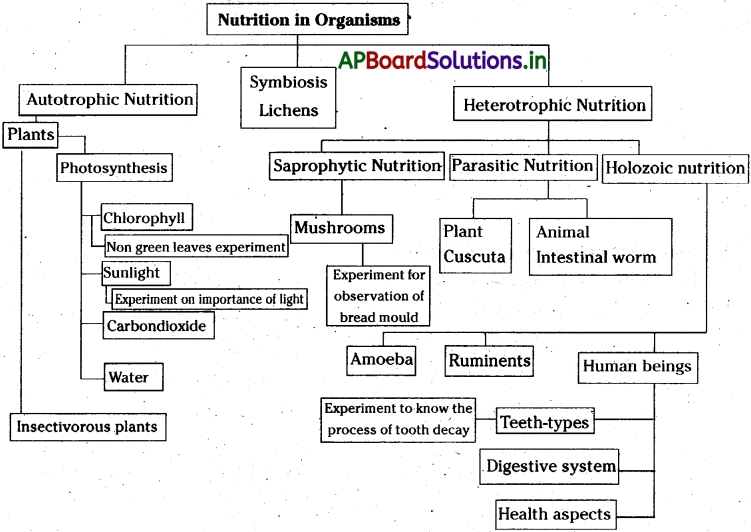Students can go through AP Board 7th Class Science Notes 3rd Lesson Nutrition in Organisms to understand and remember the concept easily.
AP Board 7th Class Science Notes 3rd Lesson Nutrition in Organisms
→ The process of intake and utilization of food by organisms s called nutrition.
→ The mode of nutrition in which organisms make food by themselves is called autotrophic nutrition.
→ The mode of nutrition in which organisms depend on other organisms for food is called Heterotrophic nutrition.
→ The process by which green plants make their own food from carbon dioxide and water by using light energy in the presence of chlorophyll is called Photosynthesis.
→ Leaves work as “food factories of plants”.
→ Chlorophyll captures the energy of the sunlight.
→ Sun light is the source of energy in the process of photosynthesis.
![]()
→ Sun is the ultimate source of energy for all living organisms.
→ Water absorbed by the roots are transported to the leaves through the stem.
→ Carbon dioxide from air is taken in to the leaves through stomata.
→ The mode of nutrition in which organisms take in nutrients in solution form from dead and decaying matter is called saprotrophic nutrition. Ex: mashroom
→ The association between two organisms for food in which one organism get benefited and other is vitiated is called parasitism. Ex: dodar, louse
→ The Holozoic Nutrition is the mode of heterotrophic nutrition in which the food is taken in solid or liquid form from the outside and is digested inside the body.
→ The steps involved in holozoic nutrition are Ingestion, Digestion, Absorption, As’simi- lation, Egestion.
→ Amoeba ingests its food with pseudopodia and digest in the food vacuole.
→ The digestive system consists of the alimentary canal and digestive glands.
→ We have four different types of teeth. Incisors, Canines, Premolars and molars.
→ Our digestive system is like a grinding machine like any other machine it also requires proper maintenance.
→ Autotrophic Nutrition : The mode of nutrition in which organisms make food by themselves is called autotrophic nutrition.
Ex: plants
![]()
→ Chlorophyll : It’s a colouring pigment present in the chloroplast of plant cell. It is responsible for the green colour of the plants.
→ Heterotrophic Nutrition : The inode of nutrition in which organisms depend on other organisms for food is called Heterotrophic nutrition.
Ex: Animals
→ Host : Organism that provide food and shelter to the parasite is called host.
→ Insectivores plant : Plants growing in the nitrogen deficient soils feed on insects. Such plants are called insectivores plants.
Ex: Nepenthes, drosera
→ Nutrition : The process of. intake and utilization of food by organisms is called nutrition.
→ Parasitic Nutrition : The association between two organisms for food in which ofte organism get benefited and other is vitiated is called parasitism. Ex : dodar, louse
→ Holozoic Nutrition : The Holozoic Nutrition is the mode of heterotrophic nutrition in which the food is taken in solid or liquid form from the outside and is digested inside the body.
Ex: Amoeba, Human being
→ Saprophytic Nutrition : The mode of nutrition in which organisms take in nutrients in solution form from dead and decaying matter is called saprotrophic nutrition.
Ex: mushrooms
→ Stomata : Openings on the lower surface of leaves through which gaseous exchange takes place.
→ Ingestion : The process of faking in of food into the body.
→ Digestion : The process of conversion of food into simple soluble forms.
→ Absorption : The process of transfer of digested food to the blood.
→ Assimilation : The process by which absorbed food become the part of the body.
→ Egestion : The process of removal of undigested food from the body.
→ Alimentary canal : Muscular tube-like structure in the digestive system in which digestive process takes place. Its about 9 meters long.
→ Pseudopodia : These are finger like projections that are pushed out from the body of amoeba. They are helpful for the movements and capturing of food.
→ Rumination : Some herbivores animals swallow their food rapidly with Out chewing and later bring back up into mouth and chew well. This process is called rumination.
→ Ruminants : Animals that perform rumination are called ruminents.
→ Villi : The inner wall of small intestine have thousands of finger-like outgrowths called villi. They absorb the digested food.
→ Tooth enamel : Enamel is the outermost layer of teeth. It is the hardest material in the human body.
→ Acidity : Discomfort caused due to excessive production of acids in the stomach is called acidity.
→ Incisors : The four front teeth in both the upper and lower jaws are called incisors. Their primary function is to cut food. They are 8 in
![]()
→ Canines : Canines are the sharp, pointed teeth that ?’t next to the incisors and look like fangs. They help in splitting the food. They are four in number.
→ Premolars : They are located between the molars in the back of the mouth and canine teeth, located in the front. They are used for tearing and crushing food. They are 8 in number.
→ Molars : They are flat teeth in the rear of the mouth. They are best at grinding food. They are 12 in number.
→ Constipation : Irregular bowl movement is referred as constipation. It caused due to deficiency of fibres in food.

